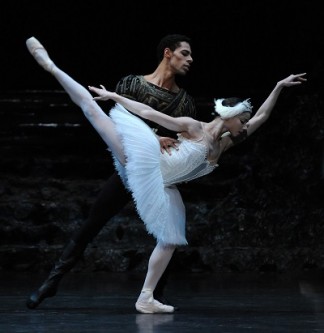 United Kingdom Pyotr Ilyich Tchaikovsky, Swan Lake: Birmingham Royal Ballet, Royal Ballet Sinfonia / Koen Kessels (conductor), Sadler’s Wells, London, 13.10.2105 (JO’D)
United Kingdom Pyotr Ilyich Tchaikovsky, Swan Lake: Birmingham Royal Ballet, Royal Ballet Sinfonia / Koen Kessels (conductor), Sadler’s Wells, London, 13.10.2105 (JO’D)

(c) Birmingham Royal Ballet
Tchaikovsky, Swan Lake
Dancers included:
Odette/Odile: Céline Gittens
Prince Siegfried: Tyrone Singleton
The Queen Mother: Marion Tate
Baron von Rothbart: Jonathan Payn
Benno (Prince Siegfried’s Friend): William Bracewell
Production
Choreography: Marius Petipa, Lev Ivanov and Peter Wright
Production: Peter Wright and Galina Samsova
Designs: Philip Prowse
Lighting: Peter Teigen
Described in the headline to an earlier review on this website as ‘ravishing’ (Philip Prowse’s designs alone make it that), Birmingham Royal Ballet’s Swan Lake is riveting, too. The audience in the packed Sadler’s Wells auditorium hardly stirred, except to leave for the intervals, from its Hamlet-like opening to its Hamlet-like close.
Giselle may be the ballet that is ‘ballet’s Hamlet’, but this Swan Lake seems to borrow from that Shakespearean tragedy. There is the funeral procession of Prince Siegfried’s father at the start. There is the figure of his friend, Benno (William Bracewell), holding Siegfried’s lifeless body at the end. Even as the final chords of Tchaikovsky’s music sound, you think of Horatio, and of Hamlet’s final words: ‘the rest is silence.’
The production, by Peter Wright (Director Laureate of the Birmingham Royal Ballet) and the Russian-born Galina Samsova, is from 1981. The choreography is credited as: ‘Marius Petipa, Lev Ivanov (choreographers of the 1895 version of the ballet in St. Petersburg) and Peter Wright’. What holds the attention is not only the dancing. It is also, and even perhaps more strongly, the way the dancing is arranged and presented in the scenic space.
Tyrone Singleton (Siegfried) has a princely bearing, an expansive port de bras, and the ability to land softly from his jumps. An attentive and secure partner, his Siegfried also has psychological depth. When tricked by Baron von Rothbart, the magician, into declaring his love for the Odile he thinks is Odette, there is space to wonder if Odile is not the Odette that this Siegfried really wants. About Tyrone Singleton’s portrayal of the role in this production, it is not so easy simply to say, as I once heard a woman say: ‘I mean, like, Siegfried? What an idiot!’
A strong dancer, with noticeable plastique, Céline Gittens steers, I think, an even keel through the roles of Odette and Odile. As Odette, she does not give herself up to Siegfried in the three backbends as completely as, say, Alina Cojocaru might give herself up. As Odile, she does not glitter as, say, Tamara Rojo might glitter. What she does let you see is Odile’s direct, challenging looks at Siegfried (you do wonder why he does not catch on to them) and the heartless mimicry of her more tentative movements as Odette. As a strong dancer, too, Céline Gittens is able to embrace Singleton in the final act in a way that shows the extent of Odette’s forgiveness of Siegfried for the breaking of his vow.
The courtiers, companions and princesses are woven in to the narrative. The cavernous courtyard of Act One is the background to the lively steps (entrechat, jeté, temps levé) that leave Siegfried unmoved, even when performed by a ‘Courtesan’ with the eloquent arms of Laura Purkiss into the bargain. Some of the dances in the equally cavernous, but differently coloured, ballroom of Act Three are more successful than others. The Czárdás does not match the speed and energy of the music being played; the Mazurka does. Kit Holder is mischievous with his tambourine in the Neopolitan Dance, here a pas de quatre, but I will always prefer this dance as Frederick Ashton’s happy, if contorted, duet (which English National Ballet perform in their Swan Lake).
And the swans? They are swans, but they are also always women dancing as swans in a Petipa ballet. They are the corps de ballet as Everywoman that Jennifer Homan’s writes about in her book, Apollo’s Angels. Making their first entrance in a zigzag line, like the Shades in La Bayadère, they refer, as women, to a space outside the confines of this particular ballet. As the leading Swan Maidens, Yvette Knight and Yijing Zhang even suggest backstories that might be as interesting to know as Odette’s.
In Act Two, the swans’ shunt hops in arabesque resemble those of the Wilis in Giselle. Only, instead of being a ‘machine for dispensing justice’, as in that ballet, they tilt their heads as they hop, and bend one wing-like arm. They sense the importance, for themselves too, of Siegfried’s falling in love with Odette. At the start of Act Four, without Odette, they mourn, on pointe and to Tchaikovsky’s funereal music, something which could have happened but which has not happened: their freedom from von Rothbart’s spell. When, almost at the end of the ballet, the spell is broken by Siegfried’s death, these swan maidens gather, on pointe, to drive the now powerless magician from the stage.
John O’Dwyer
